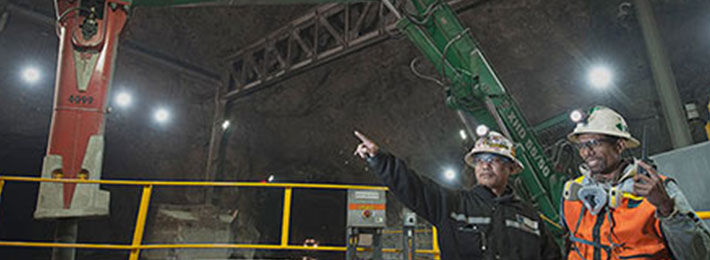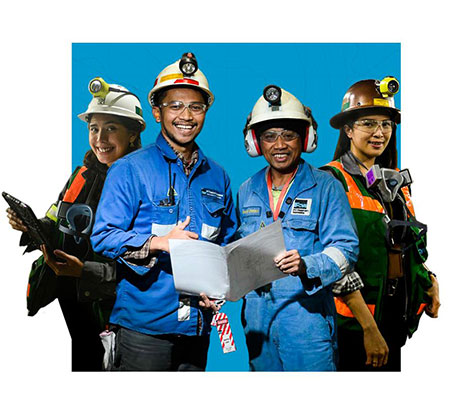12 April 2017

JAKARTA - There are several underground mines in Indonesia besides the Grasberg mine in Papua. But, the Grasberg mine managed by PT Freeport Indonesia (PTFI) since 1991, is the most special one.
The gold and copper reserve/deposit in the Grasberg mine, Papua is one of the largest in the world. The total mineral wealth reaches 3.8 billion tons.
“The Grasberg mine’s operation size is huge. It’s one of the mines with the largest production in the world. We use first-class equipment,” stated VP Underground Operations PT Freeport Indonesia, Henky Rumbino to detikFinance in Jakarta, Wednesday (4/12).
The ore production from the underground Grasberg mine once reached 80.000 ton per day, establishing it one of the largest underground mines in the world.
“The size of our ore body is 1 kilometer times 800 meter. The length is 1 km and the width 800 meter. Using the block caving method, the production of ore from the underground mine can reach 80.000 ton per day. Other underground mines worldwide are almost less in size than ours. We can produce 80.000 ton per day from one mining area,” he explained.
The deposit is huge and spread throughout a wide area, that is the reason the Grasberg underground mine must use a special method, namely block caving. Other underground mines in Indonesia use the stopping method because the mineral deposit is only concentrated over a confined area. Production scale is also far below Grasberg.
“The stopping method is used for mines with limited dimension where the mineral concentrate is concentrated in one area. On the other hand, we use the block caving method; because the ore is spread over a wide area, the grade, too, is varied. The most efficient method to meet the commercial/economic criteria is block caving. So, just one large block is collapsed. The stopping method is for smaller production, at most 2.00-3.000 ton per day. In the case of block caving it is much larger,” explained Hengky.
Block caving is an underground hard rock mining method involving undermining an ore body, allowing it to progressively collapse under its own weight, thereafter extracting it in stages through an existing tunnel network previously built.
Using this method, the underground pressure is arranged so as not to collapse. For example, a table with four legs is made to always remain stable, despite slowly cutting each leg one after the other. The difficulty and risk factor are far above the stopping method, which extracts the ore bodies then refills the soil with material. Other underground mines in Indonesia do not run rock debris risk.
“Using the stopping method, the mining method is from below upwards, the material is mined and then refilled. The content is extracted and afterwards it is filled with a type of cement and the space is the same again. Thus, the rocks are relatively stable. This is unlike block caving where the ore bodies are cut from below, and then blasted. Therefore, there is pressure accumulation from above. Existing debris must be continuously removed to prevent pressure accumulation. The risk is higher,” he explained.
In addition, in a 1.6 km-deep underground mine, the challenge to overcome is the stability of the rocks. When ore bodies are blasted the stability of the rocks must be maintained to prevent the tunnel from collapsing.
“The underground mine is managed by over 90% Indonesians. The challenge we face is, our underground mine is deep. We mine at a depth of 1.6 km below surface level. The challenges are how to ensure rock stability, how to mine well yet safe. The biggest challenge we face is mining underground and blasting the rocks,” he iterated.
An ethnic Son of Papua and a mining graduate from ITB, Bandung added, the miners working underground face the danger of wet mud slides which can submerge them underground. These are aspects which must be under control to avoid loss of lives.
“Furthermore, there also is the wet mud. This wet mud’s danger-level is very high. In a confined/narrow space, when a mud slide occurs, we may get submerged/buried under. This differs when we are in an open area, when a slide occurs we can save ourselves. This (phenomenon) is found nowhere else, worldwide,” he explained.
Further to Hengky, the difficulty factor at the Freeport underground mine is second to none, worldwide. Only Freeport is able to manage/operate a mine with a difficulty factor such as this. “Only we are able to manage some 600 wet extraction points accurately,” he concluded.
Kami menghimbau para pencari kerja untuk berhati-hati dan mewaspadai beragam modus penipuan perekrutan yang mengatasnamakan PT Freeport Indonesia. Dalam setiap proses rekrutmen dan penerimaan karyawan, PT Freeport Indonesia maupun konsultan rekruitmennya tidak memungut biaya apapun.
Untuk melihat lowongan, silakan akses melalui link berikut: ptfi e-recruitment
Untuk melihat informasi magang, silakan akses melalui link berikut: Internship Program
